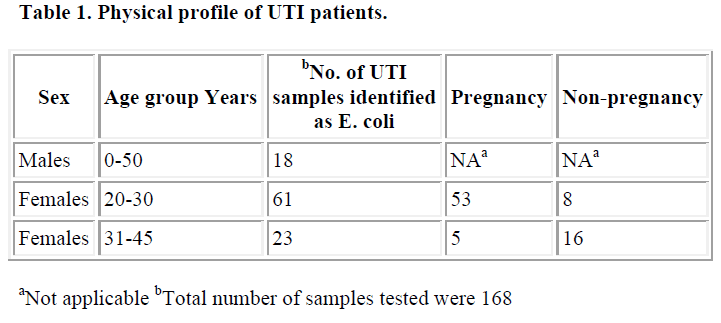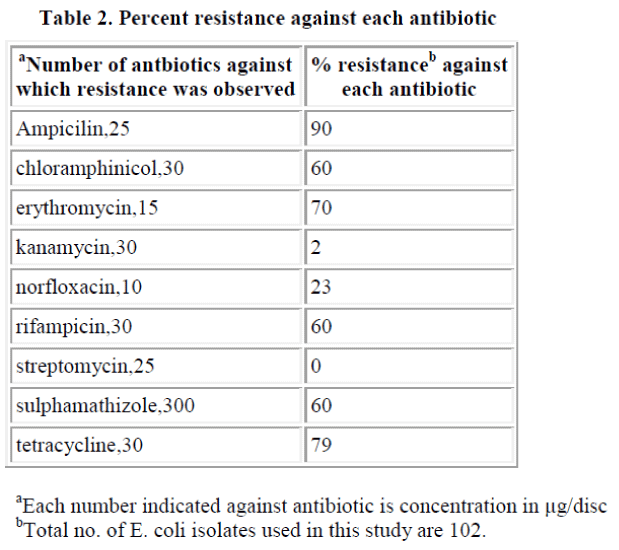- Biomedical Research (2006) Volume 17, Issue 3
Multiple drug resistance pattern in Urinary Tract Infection patients in Aligarh
Asad U Khan and Mohd S Zaman
Interdisciplinary Biotechnology Unit, Aligarh Muslim University Aligarh, India.
- Corresponding Author:
- Asad U Khan
Interdisciplinary Biotechnology Unit
Aligarh Muslim University Aligarh 202002, India
Phone: # 0091571-2723088
Fax: 0091571-2721776
E-mail: asad.k@rediffmail.com; huzzi99@hotmail.com
Accepted Date: June 21 2006
Abstract
The aim of this study was to explain the drug resistance pattern in E. coli isolated from community acquired Urinary tract infection (UTIs). A total of 168 urine samples were collected from the UTI patients followed by isolation and identification of E. coli strains. Antibiotic sensitivity and resistance analysis was performed by the disc diffusion method employing multiple antibiotic discs. The sensitivity was monitored by zone of inhibition around the disc. Clinical study revealed that this infection is more common in young pregnant women. Antibiotic susceptibility data revealed that majority of the isolates were resistant against 4 or more antibiotics. This study concludes that E. coli is one of the important causative agents of urinary tract infection in young women especially during the state of pregnancy.
Keywords
Drug resistance, E. coli, community acquired, UTI, antibiotic sensitivity
Introduction
Urinary tract infections (UTIs) are amongst the most common infections described in outpatients setting [1,2]. UTI are also the most common infection in acute and long term care hospital patients [3,4]. Escherichia coli is the most frequently found bacteria in both community acquired and hospitalized UTI patients [5-7].
Increasing resistance in bacterial pathogens is of worldwide concern. The prevalence of antimicrobial resistance in both out and hospital patients with UTI is increasing and can vary according to geographical and regional location [8,9]. In UTI infection, antimicrobial therapy is initiated even before the results of urine culture are available. Hence, there exists a great need for antimicrobial resistance surveillance at local, national and international level. There is no doubt that antimicrobial therapy is necessary when urinary tract infection (UTI) develops in pregnancy. The aim of therapy is to maintain sterile urine throughout pregnancy without causing toxicity to the mother or the fetus. However, the best mode of achieving this aim is still unclear. There is no consensus on the choice of antimicrobials, duration of therapy or on the prophylactic use of antimicrobials in pregnancy [10,11]
The aim of this study is to determine antibiotic susceptibility of E. coli prevalent in community acquired UTI infection. We have also explored the susceptibility data as well as possibility of prevalence of UTI during pregnancy. Moreover, we are also interested to find whether the resistant markers are present on the plasmid.
Methods
A total of 168 urine samples were collected from patients with community-acquired UTI during a 6 months window within the study period
Strains were plated on to the Mac Conkey agar plates. Pink colonies were observed. A well isolated single colony was picked and incubated in nutrient broth, at 37º C for 12-16 hrs. then the inoculum was spread on eosine methylene blue agar plates and incubated at 37ºC for 24 hrs., green colonies having a metallic sheen were observed. A single colony was picked up from this and was then streaked on to the hard agar plates. These plates were then kept in the incubator at 37ºC for overnight followed by characterized by battery of biochemical test. The strains were stored at -80ºC for further studies.
Antimicrobial resistance was determined by the disk diffusion method, according to National Committee for Clinical Laboratory Standards document M7-A5 [12]. Isolates showing an intermediate level of susceptibility were classified as resistant. The following antimicrobial agents at the indicated concentrations were tested: Amp (ampicillin,25), Ch (chloramphinicol,30), Er (erythromycin,15), Ka (kanamycin,30), Nx (norfloxacin,10), Rf (rifampicin,30), St (strteptomycin,25), Smy (sulphamathizole,300), Tr (tetracycline,30).Throughout this study, results were interpreted according to the National Committee for Clinical Laboratory Standards criteria for broth microdilution and disk diffusion methods [12].
Results and Discussion
A total of 168 samples were collected from patients with community acquired UTI during a 6 months window within the study period. 102 of them were identified as E. coli. Our study revealed that out of 61% of E. coli infection 17% are male patients whereas remaining are females. Moreover, age group and pregnancy conditions were also monitored as shown in table 1. Pregnancy evaluation showed that out of 59.8% (61/102) infected young women, 86.8% (52/61) were found in their early or late phases of pregnancy. This figure of reduced to 21.7% (5/23) in older pregnant women (Table 1). Other studies of UTIs in outpatients have shown E. coli to be the most common etiological agent (>80%), with a preponderance in young females (30 times> young males).
A total of 102 samples were identified as E. coli among 168 UTI samples. Their antibiotic sensitivity and resistance were tested by the method stated above. Our data showed that 90% isolates were resistant against ampicilin. Present studies also showed that 60-79% isolates were resistant against chloramphinicol, erythromycin, rifampicin, sulphamathizole, tetracycline. Norfloxacin showed intermediate resistance. The most effective antibiotics in our study against E. coli were found to be kanamycin and streptomycin, are also supported by previous studies (Table 2) [13,14].
Our study concludes that E. coli is one of the important causative agents of urinary tract infection in young women especially during the state of pregnancy. Most of the isolates showed multiple antibiotic resistance, maximum resistance was found against ampicillin whereas, least resistance was detected against streptomycin and hence it might be the drug of choice to treat UTI.
Acknowledgement
This study was supported by internal funds of Biotechnology Unit AMU Aligarh, India. Authors are thankful to Dr. Jamal Khan for providing the clinical samples and patients history.
References
- Stamm WE, Hooton TM. The management of urinary tract intection. N Engl J Med 1993; 329: 1328-1334.
- Warren JW, Abrutyn E, Hebel JR, Johnson JR, Schaeffer AJ, Stamm WE. Guidelines for antimicrobial treatment of uncomplicated acute bacterial cystis and acute pyeloephritis in women. Clin Infect Dis 199; 29: 745-758.
- Gastmeier P. Nosocomial urinary tract infection: many unresolved questions. Clin Micro Infec 2001; 7: 521-522.
- Nicolle LE, Strausbaugh LJ, Garibaldi RA. Infections and antibiotic resistance in nursing homes. Clin Microbiol Rev 1996; 9: 1-17.
- Gruneberg RN. Changes in urinary pathogens and their antibiotic sensitivities. 1971-1992. J Antimicrob Chem-other 1994; 33: 1-8.
- MacGowan AP, Brown NM, Holt HA, lovering AM, McCulloch SY, Reeves DS.An eight-year survey of the antimicrobial susceptibility patterns of 85,971 bacteria isolated from patients in a district general hospital and the local community. J Antimicrob Chemother 1993; 31: 543-557.
- Barret SP, Savage, MA, Rebec MP, Guyot A, Andrews N, Shrimpton SB. Antibiotic sensitivity of bacteria associated with community acquired urinary tract infection in Britain. J Antimicrob Chemother 1999; 44: 359-365.
- Mathai D, Jones RN, Pfaller MA. Epidemiology and frequency of resistance among pathogens causing urinary tract infection in 1,510 hospitalized patients: a report from the SENTY Antimicrobial Surveillance Program (North America) Diag Microbiol Infect Dis 2001; 40: 129-136.
- Karlowsky JA, Jones ME, Thornsberry C, Critchley, I, Kelly L, Sahm D. Prevalence of antimicrobial resistance among pathogens isolated from female outpatients across the US in 1999. Int J Antimicrob Agents 2001; 18: 121-127.
- Jamie WE, Edwards RK, Duff P. Antimicrobial susceptibility of gram-negative uropathogens isolated from obstetric patients. Infect Dis Obstet Gynecol 2002; 10: 123-126.
- Krcmery S, Hromec J, Demesova D. Treatment of lower urinary tract infection in pregnancy. Int J Antimicrob Agents 2001; 17: 279-282.
- National Committee for Clinical Laboratory Standards (NCCLS). 2000. Methods for dilution antimicrobial susceptibility tests for bacteria that grow aerobically: Approved standard – 5th edn. NCCLS document M7-A5 (ISBN 1-56238-394-9) NCCLS. Wayne, Pennsylvania 19087-1898, USA.
- Ajamaluddin M, Khan MA, Khan AU: Prevalence of multiple antibiotic resistance and Rplasmid in E. coli isolates of Hospital sewage of Aligarh City in India. Indian J Clinical Biochemistry 2000; 15: 27-32
- Khan AU and Musharraf, A. Plasmid mediated multiple antibiotic resisance in Proteous mirabilis isolated from patients with urinary tract infection. Med Sci. Monit, 2004; 10: CR598-602.

